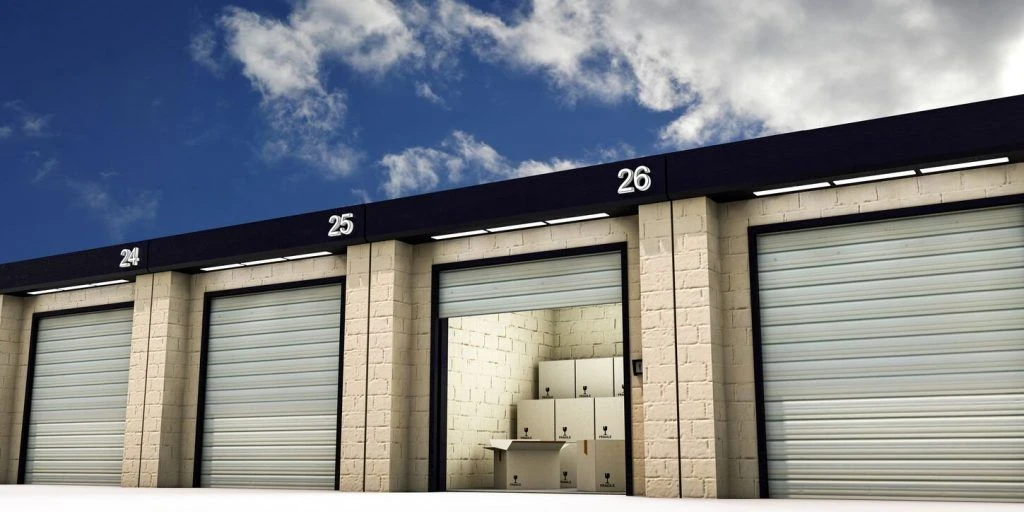
Moving Abroad

Container Shipping

Information & Popular Routes
Services

Find a Mover


If you’re moving out soon, it’s probable that you’ll need temporary moving storage. Whether you decide to store your belongings with the company that carries out the move for you or prefer to DIY it, it’s important that you’re well informed about the ins and outs of storage solutions. Because of this, we’ve compiled everything you need to become a proper moving storage expert below –from average costs to dos and don’ts, we got you covered!
Alright, let’s start with what you’re probably most interested in knowing: the average cost of moving storage. When looking to rent storage while moving, you’ll have two main options:
From these two, moving company storage is the most expensive option. On average, you can expect to pay around 20% more when renting storage from a mover than when renting the unit by yourself. After all, hiring someone to do all the work for you rather than DIYing it does unfortunately come at a cost. 😉
As with most things when it comes to moving, how much you’ll pay for storage when moving will be influenced by a few factors. However, the size of the unit is the factor that holds the most weight in the calculation of your final costs.
If you decide to store your belongings with a moving company, you can expect to pay 40¢ per cubic foot. Market averages show that you can end up paying around $239-$265 per month to store the contents of a 1-bedroom apartment, and around $159-$239 per month to store the contents of a studio apartment.
However, all of this really depends on how much you’ll need to store, so you can expect prices as high as $600 per month.
Psst! Are you still looking for a professional moving company? No need to look any further. Fill out our quote form below and we’ll do all the hard work of finding the mover that best suits your needs for you.
If you’re not afraid of a little DIY, we often recommend renting a storage unit by yourself. This is not only the cheapest option when it comes to moving storage, but also the most convenient one if your move is expected to run for longer than 6 months.
On average, you can expect to pay:
As we mentioned before, the costs of storing furniture during a move will be influenced by a number of factors. Since our job is to make your life a little easier ( 😉 ), we’ve outlined the most relevant ones to consider below.
We cannot stress this enough, the size of the unit heavily influences how much you will need to pay for storage per month. It comes as no surprise that, the larger the unit, the more expensive it will be to rent it.
Sirelo Tip! Decluttering your belongings is one of the best and easiest ways to save on your storage costs. Need a hand figuring out the most efficient way to downsize? Don’t worry, we got you! Click here to check out our tips and tricks so you can downsize your home like a total pro. 😎
The length of time for which you will be storing your belongings also plays a role in the calculation of your final moving storage costs. Of course, the longer you’ll need storage for, the higher your bill will be.
It’s good to know that most self-storage companies tend to charge on a monthly basis, which gives you the flexibility of storing your items for as long as you need –no long-term commitment required.
Believe it or not, the location of the storage facility you decide to rent also weighs in the calculation of your final moving storage costs. Unfortunately though, this isn’t something you can control if you decide to store your items with a mover.
In case you decide to rent a unit yourself, it’s good to know that prices for storage facilities are usually lower in less populated areas. So, you might be better off renting a unit in the suburbs rather than in the city if you’re looking to save yourself a few bucks.
It’s important that you’re prepared to pay additional costs if you’re looking to store unusually large items, such as:
As experts in moving, we can tell you from experience that you’re always better off acquiring insurance for your belongings –especially if they need to sit inside of a storage facility for days on end.
If you decide to store your items with a mover, it’s likely that the moving company will offer you a full-value protection insurance policy. However, it’s important that you double check with them the terms and conditions of these types of insurance, as they not always cover the storage stage of the move. The rates for these types of insurance will vary from mover to mover.
When it comes to self-storage, the insurance policies are often very affordable. You can expect to pay around 50¢ – $2 for every $100 value amount of storage.
Trust us, the extra few dollars you’ll need to invest on insurance are nothing compared to what you’ll have to invest to replace your belongings if something goes wrong. Better safe than sorry!
If you’re up for the challenge of handling the storage situation during your move by yourself, then it’s important to keep in mind that oftentimes the quotes offered by storage unit companies don’t include taxes nor fees. So, it’s likely that you will have to pay your states sales tax plus a one-off administration fee (≈$25).
The amount of storage space you’ll need will depend on the volume of the items you might need to hold off during your move. To give you a better idea of what you can expect, we’ve compiled in the table below a list of the storage unit sizes that best fit properties of different sizes.
| Size of Property | Size of Storage Unit Required |
| 1-Bedroom Apartment | 5ft. x 10 ft. |
| 2-Bedroom Apartment | 10ft. x 10ft. |
| 2-Bedroom House | 10ft. x 15ft. |
| 3-Bedroom House | 10ft. x 20ft. |
When it comes to moving storage, there’s definitely a lot of options to choose from. Since our job is to make your life a little easier, we’ve compiled the most commonly rented types of storage units for you below.
As the name suggests, an indoor storage unit is a space you rent inside a storage facility.
The benefits of renting this type of storage when moving include:
✅ Protection of your belongings against harsh weather;
✅ Possibility to add climate-controlled settings;
✅ Built-in security perks.
The disadvantages of these types of storage units include:
❌ Not fitted for large storage demands;
❌ Not fitted to store vehicles.
Just like with indoor storage units, the name for this type of storage unit is also quite self-explanatory. Generally, outside storage units are exterior spaces which typically look like a series of garages that stand one next to the other.
The advantages of this type of storage while moving include:
✅ Drive-up access;
✅ Easy loading and unloading;
✅ Fitted for storing large items (e.g.: vehicles).
The disadvantages of renting these types of storage units include:
❌ Long drives as these are often located further away from populated areas;
❌ Exposure to harsh weather conditions;
❌ Due to lack of extra security, exterior storage units are often not recommended if you’re looking to store a lot of valuable possessions.
This option is particularly relevant if you decide to take the DIY route when renting storage while moving. The most common companies when it comes to portable storage container services include the well-known PODS, 1-800-Pack-Rat, and U-Pack.
These types of storage units are portable cubes that are dropped off at your home for you to load up all your belongings. Once all your items are ready to go, the moving storage company will then pick the unit up at your house and safely drop it off at its destination.
The benefits of renting this type of storage when moving include:
✅ Delivery to your door;
✅ Loading on your schedule;
✅ Oftentimes customizable to your specific needs.
The disadvantages of these types of storage units include:
❌ Limited access once the container has been picked up;
❌ High costs associated with delivery and pick-up;
❌ Not the best option if you don’t have a large driveway to park the unit in whilst you load your belongings into it.
Before you leave, we want to make sure that we share our expert dos and don’ts when it comes to dealing with storage when moving. Ready to become the ultimate moving storage pro? Let’s go!
👍 Pack strategically and don’t forget to label the boxes;
👍 Make sure to take inventory of every single item you’re putting in storage;
👍 If you decide to go for self-storage, make sure to check out the online reviews for each storage facility you evaluate. This way, you’ll be able to dodge a bullet by avoiding untrustworthy and unprofessional companies;
👍 Purchase insurance —really, we cannot stress this enough;
👍 Take note of the storage facility’s contact details and opening hours. If you’re taking up storage with a mover, make sure to ask for these specifics as they might not be the same as the moving company’s regular contact details;
👍 Learn how to access your storage facility —this might sound like a no brainer, but sometimes it’s not as easy as it sounds!
👎 Make sure you don’t store perishables, hazardous liquids or materials, fuel, animals or yourself —yes, if we have to give a disclaimer on the latter it’s because it happens more than it definitely should;
👎 Avoid storing anything that’d be extremely expensive or impossible to replace (e.g.: family heirloom, jewelry, etc.);
👎 Never leave items unprotected, especially the fragile ones –check out our expert tips on how to pack fragile items;
👎 If you’re expecting your items to sit in storage for a long time during your move –think months–, it might be smart to avoid wrapping most things in plastic. Plastic keeps condensation inside of the wrapping, which can lead to mold, so watch out!
Congratulations, you’ve made it to the end of this crazy long article! We hope that after this insightful read you feel like a total moving storage expert.
If you need some extra information that can be helpful to plan out the rest of your move, we recommend checking out the pages below. We wish you the best of luck with your move!